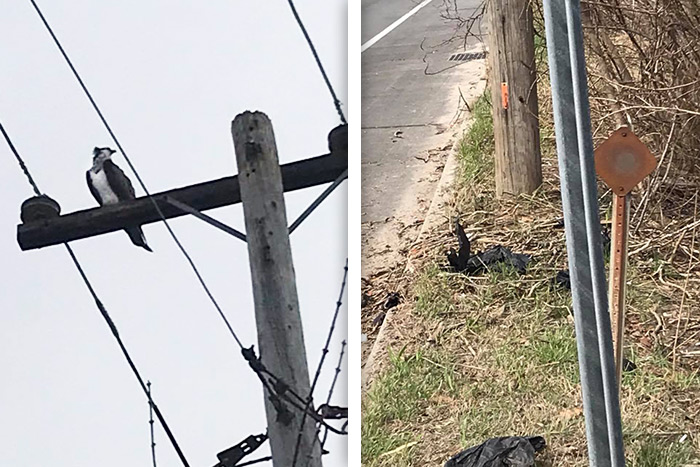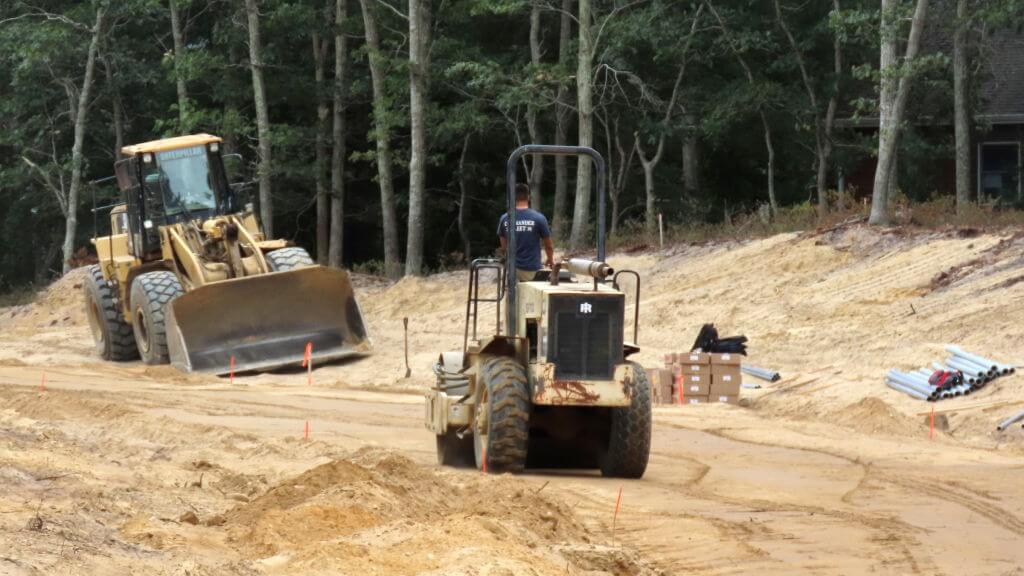Community Furious After PSEG Removes Flanders Osprey Nest

The local community was furious Monday when a PSEG crew removed an osprey nest from utility poles on Flanders Road after the power company received reports of dangerous arcing. But thanks to a very quick and public response, including a Homeless Ospreys Facebook page and a march planned for Saturday, it appears PSEG is working to give the ospreys a new home.
“This wouldn’t have happened in Sagaponack,” Terry Flanagan, the creator of the Homeless Ospreys Facebook page, said on Tuesday, noting that the ospreys were back at the pole trying to rebuild their destroyed home soon after work crews departed. “They’re trying to rebuild in the exact same spot,” Flanagan added, refuting claims that PSEG’s crew didn’t know birds occupied the nest. “They’re not supposed to remove them if they’re occupied.”
A Department of Environmental Conservation representative, who responded late Tuesday, said their information had the nest as unoccupied. “Anyone wishing to remove an osprey nest after March 15 needs to contact DEC so the agency can verify the nest is non-active,” the DEC rep explained. “If a nest is removed after March 15 without proper notification, an individual can face a DEC violation for destroying a nest of a protected bird species and potential federal violations based on the Federal Migratory Treaty Act.”
The DEC rep added that PSEG and other utility companies often “modify their infrastructure to benefit and increase potential nesting sites for osprey,” noting, “At this point in the season, osprey can and often do have the ability to re-nest if a nest is disturbed.”
On Tuesday, a rep for PSEG confirmed they are looking for a place to erect a pole with an elevated platform for the ospreys. “It was an emergency situation,” she said, explaining that the company had two reports of arcing on the pole, which has unprotected insulators. The nest was connecting the insulators and if the arcing continued, it could result in a transformer fire that would likely cause outages, not to mention burn the nest.
“If there were eggs and chicks in it there’d be nothing we could do,” the rep said, noting that PSEG must balance the needs of their customers with environmental needs.
Flanagan took photos of the birds standing at the site where their nest had been on Monday, as well as images of the debris—including sheets of black plastic—left hanging in the trees all around the pole. “They got caught with their pants down,” he said of PSEG, explaining that he sent the photos to Southampton Town Councilman John Bouvier, which led to the power company taking such quick action to give the birds a new home.

Bouvier said he sent the photos to Southampton Town Supervisor Jay Schneiderman, who then called PSEG and encouraged them to take action. “I’m relieved PSEG is acting quickly,” Bouvier said on Tuesday. “I’m glad that PSEG takes responsibility.”
Within about 24 hours of its creation, the Homeless Ospreys Facebook page had 281 followers with seven confirmed and another 17 “interested” to join their “PSEG Do the Right Thing” march on Saturday, starting in front of the nearby Tyre Masonic Lodge (200 Flanders Road) at 10:30 a.m. But it’s likely the march won’t happen, if PSEG follows through with their promises.

“That pole goes up, the march is canceled,” Flanagan said, but added, “I’ll believe it when I see it.”
According to the Department of Environmental Conservation, osprey populations went into great decline between the 1940s and 1969, going from 1,000 active nests between New York City and Boston, to an estimated 150 nests. The bird have since mounted a comeback, after New York banned the insecticide DDT in 1971, and the rest of the country banned it in 1972. DDT caused eggshell thinning, which reduced the birds’ reproductive output.
Ospreys were listed as endangered in 1976. They were later downgraded to threatened in 1983, and have been further downgraded to a special concern species since 1999, the DEC reports. By 1995, the population had grown to 230 breeding pairs just on Long Island.
“When these birds are back, it’s a big deal for this community,” Flanagan said, explaining his swift response toward helping the displaced ospreys.



